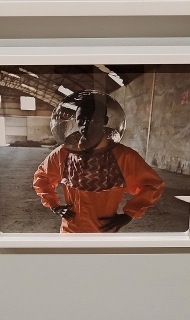From Zambia to the moon and Mars
UNTIL THE 14TH OF JANUARY 2024, there is a fascinating exhibition at London’s Tate Modern gallery. Called “A World in Common: Contemporary African Photography”, this is a display of a wide variety of photographic works (still and cinematographic) showing various aspects of life in the African continent past and present. Although many of the exhibits were both eye-catching and fascinating, one – a series of photographs by Cristina de Middel (born 1975) – interested me especially. Titled “Afronauts series 2012”, it commemorates a project, which few people remember outside Zambia.

Between 1960 and 1969, the founder of the Zambia National Academy of Science, Space Research and Philosophy, Edward Festus Mukuka Nkoloso (1919–1989), worked on Zambia’s space programme. During a period when the USSR and the USA were competing to make advances in space exploration, Nkoloso felt that Zambia and the rest of Africa should join the space race. His aim was to launch a rocket, which would transport two cats, an astronaut, and a Christian missionary, to the moon. 17-year-old Ms Matha Mwambwa was chosen to be the first ‘afronaut’. After landing on the moon, they were to have been sent onwards to Mars.
Nkoloso set up a training camp near Lusaka. A website (https://www.rmg.co.uk/stories/topics/zambian-space-programme) describes this:
“In an attempt to achieve this mission to the Moon Nkoloso recruited twelve astronauts, and put them through rigorous training of his own devising. He put them in an oil drum, spun them round trees and rolled them down hills in order to prepare them for weightlessness. He taught them to walk on their hands as he believed this to be the way to walk in space. He made them swing on a rope, before cutting the rope to allow them to experience freefall.”
Despite seeking funding from various countries – always unsuccessfully – the programme failed. In addition to lack of funding, other disasters hit the project before it could take-off from the ground. These are described in the website already quoted:
“Mwamba fell pregnant and returned home. Other astronauts left, reportedly going on drinking sprees and never returning or moving onto other pastimes such as tribal song and dance. And with no astronauts and no money, the Moon can seem awfully far away.”
De Middel’s exhibit at the Tate Modern is loosely based on the story of Zambia’s space programme. She has combined fact with fiction to produce a series of photographs depicting fantasy images of the failed project. Some of her photographs show afronauts wearing glass domes on their heads instead of astronauts’ helmets. De Middel’s elderly grandmother made the costumes worn by the subjects posing as afronauts. The artist’s image show simulations of space travel that are very distant from the images issued by NASA and other space exploration agencies. In a way, the exhibit asks the question: “Who is it that gets to explore space?”
I am pleased that I saw the exhibition, which is well-displayed and often thought-provoking. However, I am extremely happy that by visiting this show, I learned about an almost forgotten competitor in the space race. Recently, India landed a mission on the moon. Maybe, it is now Africa’s turn to make space exploration history.



